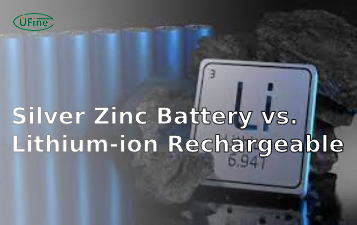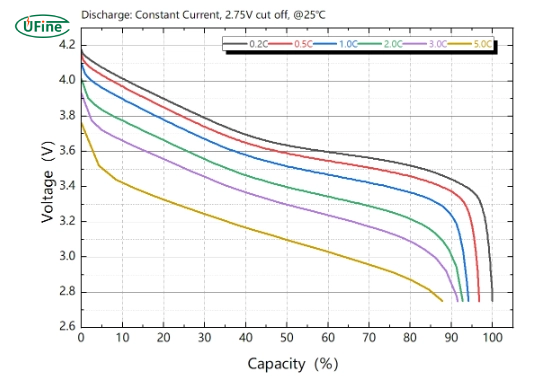
- Part 1. What is the li-ion battery self-discharge rate?
- Part 2. Factors influencing li-ion battery self-discharge rate
- Part 3. How to prevent li-ion battery self-discharge from being too high?
- Part 4. How to measure the lithium-ion battery self-discharge rate?
- Part 5. How does Ufine measure the self-discharge rate of lithium-ion batteries?
The self-discharge rate of Li-ion batteries stands as a pivotal factor influencing their performance and longevity. This article dives deep into the realm of Li-ion battery self-discharge, exploring its rate, the driving factors behind it, and effective strategies to curtail excessive discharge, ensuring optimal battery performance.
Part 1. What is the li-ion battery self-discharge rate?
The self-discharge rate of a lithium-ion (Li-ion) battery refers to the gradual loss of its stored charge over time when the battery is inactive and not connected to any external load. It represents the percentage of charge lost per unit of time, typically measured monthly, showcasing the battery’s natural discharge tendency due to internal chemical reactions, regardless of external connections, influencing its overall capacity and performance.
Part 2. Factors influencing li-ion battery self-discharge rate
Temperature
Higher temperatures expedite self-discharge by fostering heightened chemical reactions within the battery cells, resulting in accelerated energy depletion. Conversely, cooler temperatures decelerate the self-discharge process, effectively conserving the battery’s charge. Ideally, maintaining storage temperatures between 15°C to 25°C (59°F to 77°F) ensures optimal conditions for minimizing self-discharge and preserving the battery’s stored energy over time.
Chemistry and composition
The chemistry and composition of lithium-ion batteries directly influence their self-discharge rates. Different electrode materials, such as lithium iron phosphate (LiFePO4) or lithium cobalt oxide (LiCoO2), exhibit varying levels of self-discharge due to their distinct chemical reactions during storage. For instance, LiFePO4 typically demonstrates lower self-discharge rates compared to LiCoO2 due to its inherently more stable structure, which mitigates side reactions leading to less stored energy loss over time.
Electrolyte stability
The stability of the electrolyte significantly impacts self-discharge. Electrolytes with higher stability, such as solid-state electrolytes or certain additives in liquid electrolytes, reduce unwanted side reactions within the battery. For example, solid-state electrolytes show promising potential to minimize self-discharge rates owing to their inherent stability, preventing degradation over extended periods.
Electrode interface
The interface between the electrode and electrolyte influences self-discharge. Enhanced electrode interfaces, achieved through improved coatings or optimized contact between the electrode and electrolyte, minimize unwanted reactions and improve overall stability. For instance, applying protective coatings or using conductive additives can enhance the electrode interface, reducing self-discharge rates by preventing moisture or contaminants from affecting the battery’s performance during storage.
State of charge during storage
The initial state of charge during battery storage impacts self-discharge. Batteries stored at full charge experience higher self-discharge rates than those stored at partial charges. Keeping batteries at lower charge levels, around 40%-60% state of charge, diminishes degradation reactions, contributing to lower self-discharge rates during prolonged storage periods.
Battery age
As lithium-ion batteries age, the degradation of internal components such as electrodes and electrolytes leads to higher self-discharge rates over time. This degradation involves irreversible chemical changes within the battery, resulting in increased internal resistance and the acceleration of self-discharge processes.
Part 3. How to prevent li-ion battery self-discharge from being too high?
What measures can lithium battery manufacturers take during the production process to avoid delivering batteries with high self-discharge to customers? Ufine Has taken the following measures:
Control production environment
Controlling temperature and humidity is key to reducing battery self-discharge during production. Maintaining a constant temperature and humidity can prevent changes in chemical reactions in the battery, thereby reducing self-discharge.
Use high-quality raw materials
Using high-quality positive and negative electrodes, separators, and other raw materials can reduce impurities and defects inside the battery, thereby reducing self-discharge.
>Strict quality control
During production, strict quality control can ensure that the battery’s performance and quality meet standards. Charging, discharging, temperature, and other tests can eliminate batteries with high self-discharge rates, thereby improving product consistency and reliability.
Charging treatment
Charging the battery during production can reduce its self-discharge rate. Charging can restore the chemical reactions in the battery to the optimal state, thereby reducing self-discharge.
Part 4. How to measure the lithium-ion battery self-discharge rate?
Resting voltage method
To measure the self-discharge rate, start by fully charging the lithium-ion battery. Allow it to rest for a specific duration, usually 24 hours, without any load or charging. After the resting period, measure the battery’s voltage using a multimeter or voltage meter. The voltage drop indicates the self-discharge rate.
Capacity test method
Perform a full charge on the lithium-ion battery and then discharge it completely using a controlled load. Record the initial and final capacity levels during this discharge cycle. After allowing the battery to rest, calculate the difference between the two capacity levels. This variance signifies the self-discharge rate as a percentage of the total capacity.
Coulomb counting method
Employ a sophisticated battery management system (BMS) that tracks the Coulomb count—accurately measuring the charge and discharge cycles of the battery. By monitoring the Coulombs withdrawn during rest periods, one can calculate the self-discharge rate per unit of time.
Internal resistance measurement
Utilize specialized equipment capable of measuring the internal resistance of lithium-ion batteries. A rise in internal resistance over a resting period indicates self-discharge. By comparing the initial and final internal resistance values, you can derive the self-discharge rate.
Accelerated aging tests
Conduct accelerated aging tests under controlled environmental conditions, simulating real-world usage scenarios. Monitor voltage fluctuations, capacity loss, and internal resistance changes over the aging period to calculate the self-discharge rate accurately.
Environmental factors consideration
During measurements, ensure a stable and controlled environment—consistent temperature and humidity levels—as environmental conditions significantly impact self-discharge rates.
Part 5. How does Ufine measure the self-discharge rate of lithium-ion batteries?
UFine battery employs an Automated Testing System (ATS) to assess the self-discharge rate of its batteries. This ATS represents an advanced automated testing device designed explicitly for rapid assessment of extensive batches of batteries. Its primary function is to automate the testing process and record data efficiently.
Advantages of ATS in battery testing
This cutting-edge method drastically enhances testing efficiency and accuracy by eliminating potential human errors and time constraints associated with manual testing procedures. It operates seamlessly, allowing for swift and precise testing across a large volume of batteries.
Battery quality assurance
By leveraging this automated system, UFine can conduct thorough self-discharge rate evaluations swiftly and consistently, ensuring reliable and precise assessments of each battery’s performance. The ATS facilitates a streamlined and reliable testing process, contributing to the assurance of battery quality and performance standards upheld by Ufine.
Related Tags:
More Articles

What is the Difference Between Silver Zinc Battery vs. Lithium-ion Rechargeable?
Compare silver zinc and lithium-ion rechargeable batteries: energy density, cycle life, safety, cost, and uses in drones, medical devices, EVs, and electronics.
What are Watts and Watt Hours in Battery?
Understand watt vs watt-hour in batteries: key differences, how to calculate capacity, and why they matter. Includes free comparison table.
Best 10 Blood Pressure Monitor Battery Review: Finding the Most Reliable
Are you looking for a reliable Blood Pressure Monitor battery? Here is a complete guide with the top 10 best blood pressure monitor batteries.
Bluetooth Headphone Battery Guide: All You Need to Know
Maximize headphone battery life with expert tips! Learn how to charge, check, troubleshoot, and choose the best bluetooth headphone battery in 2025.
LiFePO4 Battery VS. Lithium-ion Polymer Battery: Which One Is Best?
Comprehensive comparison of LiFePO4 vs Lithium Ion Polymer batteries: energy density, safety, lifespan, cost. Find out which battery suits your needs in 2025.



